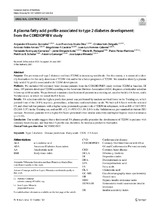A plasma fatty acid profile associated to type 2 diabetes development: from the CORDIOPREV study
Autor
Villasanta-González, Alejandro
Alcalá Díaz, Juan Francisco
Vals-Delgado, Cristina
Arenas, Antonio Pablo
Cardelo, Magdalena P.
Romero-Cabrera, Juan Luis
Rodríguez-Cantalejo, Fernando
Delgado-Lista, Javier
Malagón, María M.
Pérez-Martínez, Pablo
Schulze, Matthias B.
Camargo García, A.
López-Miranda, José
Editor
SpringerFecha
2021Materia
Type 2 diabetesDisease prediction
Fatty acids
COX
FA Score
METS:
Mostrar el registro METSPREMIS:
Mostrar el registro PREMISMetadatos
Mostrar el registro completo del ítemResumen
Purpose: The prevalence of type 2 diabetes mellitus (T2DM) is increasing worldwide. For this reason, it is essential to identify biomarkers for the early detection of T2DM risk and/or for a better prognosis of T2DM. We aimed to identify a plasma fatty acid (FA) profile associated with T2DM development. Methods: We included 462 coronary heart disease patients from the CORDIOPREV study without T2DM at baseline. Of these, 107 patients developed T2DM according to the American Diabetes Association (ADA) diagnosis criteria after a median follow-up of 60 months. We performed a random classification of patients in a training set, used to build a FA Score, and a Validation set, in which we tested the FA Score. Results: FA selection with the highest prediction power was performed by random survival forest in the Training set, which yielded 4 out of the 24 FA: myristic, petroselinic, α-linolenic and arachidonic acids. We built a FA Score with the selected FA and observed that patients with a higher score presented a greater risk of T2DM development, with an HR of 3.15 (95% CI 2.04–3.37) in the Training set, and an HR of 2.14 (95% CI 1.50–2.84) in the Validation set, per standard deviation (SD) increase. Moreover, patients with a higher FA Score presented lower insulin sensitivity and higher hepatic insulin resistance (p < 0.05). Conclusión: Our results suggest that a detrimental FA plasma profile precedes the development of T2DM in patients with coronary heart disease, and that this FA profile can, therefore, be used as a predictive biomarker.

